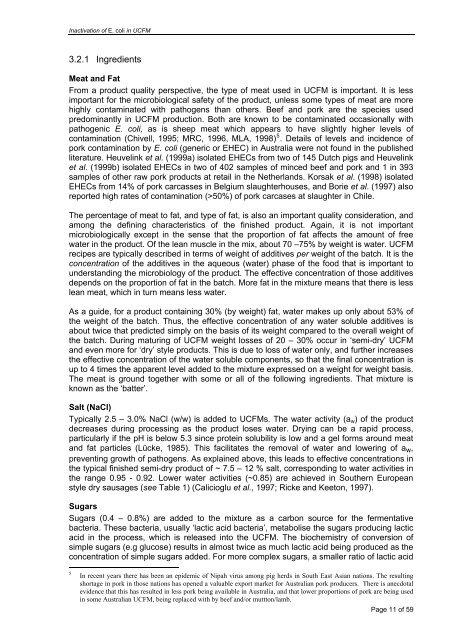Download "Predicting E. coli inactivation in uncooked comminuted ...
Download "Predicting E. coli inactivation in uncooked comminuted ...
Download "Predicting E. coli inactivation in uncooked comminuted ...
Create successful ePaper yourself
Turn your PDF publications into a flip-book with our unique Google optimized e-Paper software.
Inactivation of E. <strong>coli</strong> <strong>in</strong> UCFM3.2.1 IngredientsMeat and FatFrom a product quality perspective, the type of meat used <strong>in</strong> UCFM is important. It is lessimportant for the microbiological safety of the product, unless some types of meat are morehighly contam<strong>in</strong>ated with pathogens than others. Beef and pork are the species usedpredom<strong>in</strong>antly <strong>in</strong> UCFM production. Both are known to be contam<strong>in</strong>ated occasionally withpathogenic E. <strong>coli</strong>, as is sheep meat which appears to have slightly higher levels ofcontam<strong>in</strong>ation (Chivell, 1995; MRC, 1996, MLA, 1998) 5 . Details of levels and <strong>in</strong>cidence ofpork contam<strong>in</strong>ation by E. <strong>coli</strong> (generic or EHEC) <strong>in</strong> Australia were not found <strong>in</strong> the publishedliterature. Heuvel<strong>in</strong>k et al. (1999a) isolated EHECs from two of 145 Dutch pigs and Heuvel<strong>in</strong>ket al. (1999b) isolated EHECs <strong>in</strong> two of 402 samples of m<strong>in</strong>ced beef and pork and 1 <strong>in</strong> 393samples of other raw pork products at retail <strong>in</strong> the Netherlands. Korsak et al. (1998) isolatedEHECs from 14% of pork carcasses <strong>in</strong> Belgium slaughterhouses, and Borie et al. (1997) alsoreported high rates of contam<strong>in</strong>ation (>50%) of pork carcases at slaughter <strong>in</strong> Chile.The percentage of meat to fat, and type of fat, is also an important quality consideration, andamong the def<strong>in</strong><strong>in</strong>g characteristics of the f<strong>in</strong>ished product. Aga<strong>in</strong>, it is not importantmicrobiologically except <strong>in</strong> the sense that the proportion of fat affects the amount of freewater <strong>in</strong> the product. Of the lean muscle <strong>in</strong> the mix, about 70 –75% by weight is water. UCFMrecipes are typically described <strong>in</strong> terms of weight of additives per weight of the batch. It is theconcentration of the additives <strong>in</strong> the aqueous (water) phase of the food that is important tounderstand<strong>in</strong>g the microbiology of the product. The effective concentration of those additivesdepends on the proportion of fat <strong>in</strong> the batch. More fat <strong>in</strong> the mixture means that there is lesslean meat, which <strong>in</strong> turn means less water.As a guide, for a product conta<strong>in</strong><strong>in</strong>g 30% (by weight) fat, water makes up only about 53% ofthe weight of the batch. Thus, the effective concentration of any water soluble additives isabout twice that predicted simply on the basis of its weight compared to the overall weight ofthe batch. Dur<strong>in</strong>g matur<strong>in</strong>g of UCFM weight losses of 20 – 30% occur <strong>in</strong> ‘semi-dry’ UCFMand even more for ‘dry’ style products. This is due to loss of water only, and further <strong>in</strong>creasesthe effective concentration of the water soluble components, so that the f<strong>in</strong>al concentration isup to 4 times the apparent level added to the mixture expressed on a weight for weight basis.The meat is ground together with some or all of the follow<strong>in</strong>g <strong>in</strong>gredients. That mixture isknown as the ‘batter’.Salt (NaCl)Typically 2.5 – 3.0% NaCl (w/w) is added to UCFMs. The water activity (a w ) of the productdecreases dur<strong>in</strong>g process<strong>in</strong>g as the product loses water. Dry<strong>in</strong>g can be a rapid process,particularly if the pH is below 5.3 s<strong>in</strong>ce prote<strong>in</strong> solubility is low and a gel forms around meatand fat particles (Lücke, 1985). This facilitates the removal of water and lower<strong>in</strong>g of a w ,prevent<strong>in</strong>g growth of pathogens. As expla<strong>in</strong>ed above, this leads to effective concentrations <strong>in</strong>the typical f<strong>in</strong>ished semi-dry product of ~ 7.5 – 12 % salt, correspond<strong>in</strong>g to water activities <strong>in</strong>the range 0.95 - 0.92. Lower water activities (~0.85) are achieved <strong>in</strong> Southern Europeanstyle dry sausages (see Table 1) (Calicioglu et al., 1997; Ricke and Keeton, 1997).SugarsSugars (0.4 – 0.8%) are added to the mixture as a carbon source for the fermentativebacteria. These bacteria, usually ‘lactic acid bacteria’, metabolise the sugars produc<strong>in</strong>g lacticacid <strong>in</strong> the process, which is released <strong>in</strong>to the UCFM. The biochemistry of conversion ofsimple sugars (e.g glucose) results <strong>in</strong> almost twice as much lactic acid be<strong>in</strong>g produced as theconcentration of simple sugars added. For more complex sugars, a smaller ratio of lactic acid5In recent years there has been an epidemic of Nipah virus among pig herds <strong>in</strong> South East Asian nations. The result<strong>in</strong>gshortage <strong>in</strong> pork <strong>in</strong> those nations has opened a valuable export market for Australian pork producers. There is anecdotalevidence that this has resulted <strong>in</strong> less pork be<strong>in</strong>g available <strong>in</strong> Australia, and that lower proportions of pork are be<strong>in</strong>g used<strong>in</strong> some Australian UCFM, be<strong>in</strong>g replaced with by beef and/or muttton/lamb.Page 11 of 59


